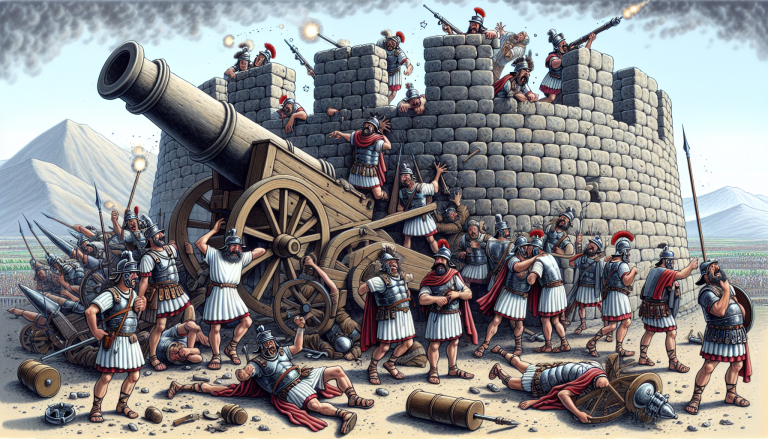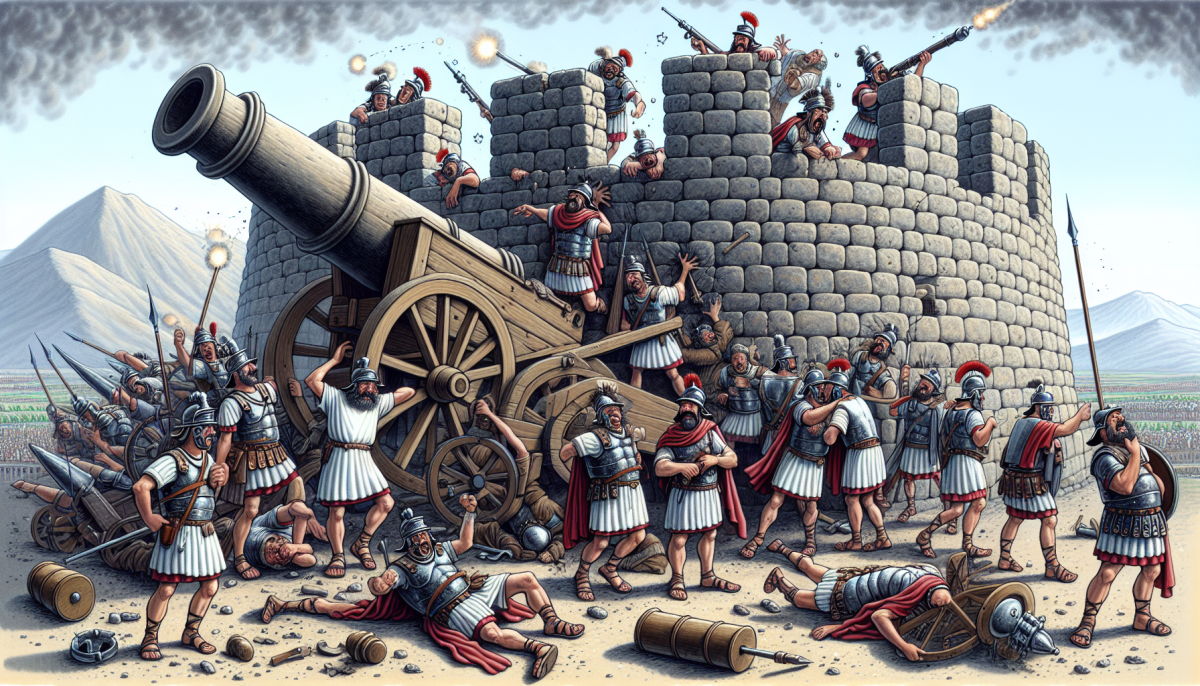The Doomed Siege of Alesia: A Comedic Retelling of Caesar’s Futile Endeavor

In the annals of history, there are moments so absurd, so utterly futile, that they beg to be retold with a healthy dose of laughter and satire. And few events fit that bill quite like the infamous siege of Alesia, where Julius Caesar’s legions found themselves engaged in a battle that would make even the most seasoned military strategist cringe.
The year was 52 BCE, and Caesar, the ever-ambitious Roman general, had set his sights on the Gallic stronghold of Alesia. Determined to crush the last vestiges of Gallic resistance, he embarked on a campaign that would go down in history as a textbook example of “beating a dead horse.”
As Caesar’s forces surrounded the city, they set about constructing an elaborate network of fortifications, trenches, and palisades, determined to starve the Gauls into submission. Little did they know that their efforts would soon descend into the realm of the absurd.
The Great Siege of Alesia: A Comedy of Errors
The Gauls, led by the indomitable Vercingetorix, were not about to go down without a fight. As Caesar’s men toiled away, building their elaborate defenses, the Gauls looked on with a mixture of amusement and exasperation.
“Look at them,” Vercingetorix is said to have remarked, “Digging trenches and erecting walls as if they were nailing jello to a tree.”
And as the siege dragged on, the Gauls only seemed to grow more and more amused by the Romans’ futile efforts. They would taunt the legionnaires, hurling insults and tossing the occasional rotten vegetable over the walls, much to the dismay of the already frustrated Caesar.
“I can’t believe we’re wasting our time on this,” one legionnaire was overheard grumbling. “It’s like we’re beating a dead horse, and the horse is laughing at us the whole time.”
But Caesar, ever the stubborn commander, refused to admit defeat. He doubled down on his efforts, ordering his men to construct an even more elaborate series of fortifications, complete with a second ditch, a second wall, and even a third wall for good measure.
“It’s like he’s trying to build a fortress within a fortress,” another legionnaire remarked, shaking his head in disbelief. “At this rate, we’ll be here until the end of time.”
The Cavalry Arrives (and Promptly Leaves)
Just when it seemed that Caesar’s siege was doomed to failure, a glimmer of hope appeared on the horizon. News arrived that a massive Gallic relief army, led by the chieftains of various tribes, was marching to the aid of Vercingetorix and his beleaguered forces.
Caesar, sensing an opportunity to finally break the stalemate, quickly mobilized his own troops, determined to meet the Gallic reinforcements head-on. But as the two armies clashed in a fierce battle outside the walls of Alesia, the legionnaires soon found themselves overwhelmed by the sheer numbers of their opponents.
“It’s like we’re trying to hold back the tide with a pitchfork,” one soldier was heard muttering, as he frantically parried the blows of his Gallic adversaries.
Just when it seemed that all was lost, a curious thing happened. The Gallic relief army, having witnessed the seemingly impregnable defenses that Caesar had constructed, suddenly lost their nerve and began to retreat.
“They took one look at those walls and just turned around and ran,” a legionnaire later recounted, a bemused expression on his face. “I guess they figured it wasn’t worth the trouble.”
Caesar, seizing the opportunity, ordered his troops to pursue the retreating Gauls, inflicting heavy casualties and effectively crushing the last major threat to his siege.
The Inglorious Surrender of Vercingetorix
With the Gallic relief force routed, the siege of Alesia entered its final, and perhaps most comical, stage. Vercingetorix and his beleaguered defenders, faced with the prospect of certain starvation, finally conceded defeat.
But the manner of their surrender would go down in history as the ultimate in futility and humiliation.
As Caesar’s legionnaires marched into the city, they were greeted by the sight of Vercingetorix, the once-proud Gallic chieftain, mounted atop his horse and dressed in full regalia.
“Behold, the mighty Vercingetorix!” one legionnaire reportedly shouted, his voice dripping with sarcasm. “Come to surrender himself and his people, like a true hero.”
Vercingetorix, apparently determined to maintain his dignity to the bitter end, slowly dismounted his horse and approached Caesar, offering his sword in a ceremonial gesture of surrender.
“I wonder if he practiced that move in front of a mirror,” another legionnaire whispered to his comrade, barely stifling a laugh.
As Vercingetorix knelt before the victorious Caesar, the legionnaires could barely contain their amusement. It was as if the Gallic leader had taken a page from the comedy playbook, determined to make his defeat as melodramatic and over-the-top as possible.
“It’s like he’s trying to win an Oscar for ‘Best Surrendering Chieftain,'” one soldier remarked, earning a hearty round of laughter from his companions.
The Lasting Legacy of the Siege of Alesia
In the end, the siege of Alesia stands as a testament to the futility of human folly, a cautionary tale of the perils of stubbornness and the dangers of “beating a dead horse.”
Caesar, for all his military genius, had been reduced to a commander whose every move was met with derision and laughter, his grand plans unraveling like a cheap tapestry in the face of Gallic resilience and sheer absurdity.
And Vercingetorix, the once-proud leader of the Gallic resistance, had become a caricature of himself, his dramatic surrender a bizarre and ultimately futile gesture in the face of overwhelming odds.
As the legionnaires marched back to Rome, their tales of the siege of Alesia no doubt became the stuff of legend, a reminder that even the mightiest of empires can be brought low by the sheer power of human folly and the occasional well-placed rotten vegetable.
